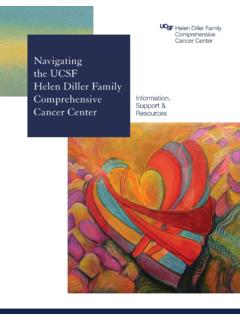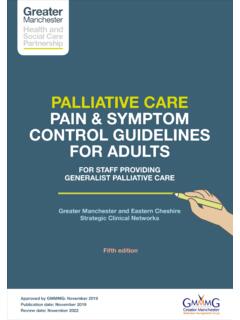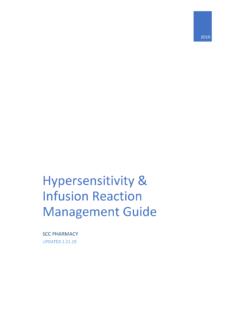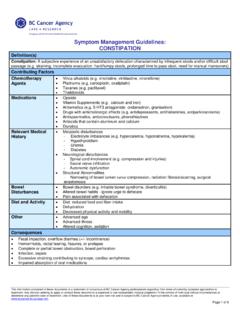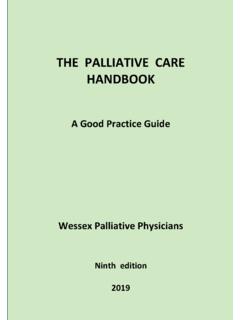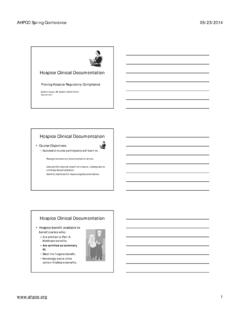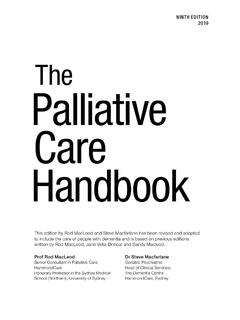Transcription of End-of-Life Care for Brain Tumor Patients - UCSF Health
1 End-of-Life Care for Brain Tumor PatientsManual for Health Care Providers AUTHORS:Susan M. Chang, MDErin Dunbar, MDVirginia Dzul-Church, MDLaura Koehn, MDMargaretta S. Page, RN, MSNeuro-Oncology Gordon Murray Caregiver Program UNIVERSITY OF CALIFORNIA, SAN FRANCISCOCONTENTS: INTRODUCTION .. 1 Neuroanatomy .. 2 THE USE OF STEROIDS .. 3 Role of 3 Managing Steroids .. 4 Side 4 symptom MANAGEMENT .. 7 Drowsiness .. 10 Focal Neurological Symptoms .. 11 Cognitive, Behavioral, and Emotional Changes .. 16 Delirium .. 22 Dysphagia .. 25 SOCIAL ISSUES .. 27 Children in the Home .. 28 Caregiver 29 CONCLUSION .. 31 End-of-Life Care for Brain Tumor PatientsManual for Health Care Providers Introduction The goal of this manual is to provide an overview of what Health professionals may expect, as well as offer guidance, in caring for someone with a progressive, life-threatening Brain Tumor , with a particular focus on end- of-life issues.
2 Although some of the problems Brain Tumor Patients experience at the end of life are common with many other forms of cancer, there is a subset of challenging problems unique to Patients with Brain tumors. In fact, the End-of-Life phase for Brain Tumor Patients tends to have a different course than general cancer Patients . The intent of this manual is to suggest recommendations regarding disease-specific symptoms. Over time, recommendations will likely change as new supportive treatments are incorporated into clinical care. We understand that each patient s situation is unique and that the end of life is different for each patient. Some of these recommendations may not be pertinent to a particular situation. We hope that you will use this as a guide to supplement your knowledge of End-of-Life care. End-of-Life Care for Brain Tumor Patients / Manual for Health Care ProvidersPAGE 1 Neuroanatomy Brain tumors represent a wide variety of Tumor types that either originate in the Brain or have metastasized from somewhere else.
3 Because the symptoms commonly seen in the End-of-Life phase of Brain Tumor Patients are a consequence of Tumor location, it may be helpful to have a general sense of the anatomy of the Brain . Knowing where the Tumor is located will help you anticipate what type(s) of symptoms you may encounter. Below is a diagram of the Brain outlining the major areas and a summary of the major functions. FRONTAL LOBE: Movement, intelligence, reasoning, behavior, memory, personality, planning, decision-making, judgment, initiative, inhibition, and moodTEMPORAL LOBE: Speech, behavior, memory, hearing, vision, and emotionsPARIETAL LOBE: Intelligence, reasoning, knowing right from left, language, sensation, reading, and understanding where the body is in spaceOCCIPITAL LOBE: Vision and perceptionCEREBELLUM: Balance, coordination, and muscle toneBRAINSTEM: Heart rate, blood pressure, cranial nerve connections (smell, taste, eye movements), and all connections from Brain to spinal cord carrying motor and sensory informationEnd-of-Life Care for Brain Tumor Patients / Manual for Health Care ProvidersPAGE 2 VIGNETTE.
4 A 42-year-old woman with glioblastoma multiforme has been noted to have worsening dull headache, which is worst in the morning, with associated nausea and vomiting . She has taken multiple pain medications including acetaminophen, ibuprofen, and oxycodone without relief. She has also taken ondasetron and prochlorperazine with moderate relief of her nausea . What else should you consider to help with her symptoms?Role of SteroidsWhat is the role of steroids in treating Patients with primary Brain tumors? What are indications for use?A steroid such as dexamethasone is the most common medication prescribed to Brain Tumor Patients to control cerebral edema and in turn manage symptoms. That said, there are many side effects and complications related to taking the drug that are particularly important to be aware of in End-of-Life are hormonal molecules that can cross the blood Brain barrier and act as analgesic agents by (1) decreasing inflammation by inhibiting the synthesis of prostaglandin and (2) reducing tissue edema by decreasing vascular permeability.
5 Due to these mechanisms, cortico-steroids are the mainstay of treatment for relief of symptoms of increased intracranial pressure resulting from a Brain Tumor . These symptoms include nausea , vomiting , and headache, as well as focal neurological deficits such as weakness and language dysfunction. The Use of SteroidsEnd-of-Life Care for Brain Tumor Patients / Manual for Health Care ProvidersPAGE 3 Managing SteriodsHow do you manage steroids? What is the steroid of choice?Corticosteroids, including hydrocortisone, dexamethasone, prednisone, prednisolone, and methylprednisolone, are the mainstay of treat-ment of increased Brain pressure. Steroid doses should be adjusted to maximize pain relief and minimize side effects. Dexamethasone (Decadron) is the cortico-steroid best supported by clinical experience, evidence, and guidelines issued by expert panel.
6 It causes less fluid retention because of its lesser mineralocorticoid effect, has a longer half-life and thus can be taken once daily, and offers a higher is a good trial and how do I titrate the dose? Each patient warrants a brief trial of cortico-steroids for symptom control of headache, nausea , and vomiting . Administration of cortico-steroids should preferably not take place later than 2 PM in order to minimize the undesirable effects of insomnia and restlessness as well as to maximize the desirable effects, such as analgesia, support of daytime alertness, and to improve appetite. Common regimens include: 4-6 mg oral daily for mild symptoms; 8 mg oral daily with breakfast for moderate symptoms; and 8 mg orally at breakfast and 8 mg at lunch for severe symptoms. Three days may be an adequate trial for many situations ( , headache), with tapering soon after initiation to a minimum effective dose with the least side effects.
7 The corticosteroid should be discontinued if not found to benefit the individual within a week. If effective, the corticosteroid should be maintained at the minimum dose that provides sufficient symptom control with the least side effects. In general, Patients should be maintained on the corticosteroid for less than 3 weeks, but the decision of when and whether to discontinue the corticosteroid should hinge on patient-specific factors ( , prognosis, likelihood of side effects from withdrawal, potential to exacerbate other symptoms being masked by the drug). How and when do I taper steroids?Because most corticosteroid side effects manifest over the long-term, general consensus holds that these drugs are best used for a limited time, at the lowest effective dose, and with frequent monitoring. Corticosteroids are advised for short-term courses of therapy, from 1 to 3 weeks.
8 Corticosteroids are used for longer than 3 weeks for Patients who have a short- to medium-term prognosis ( , < 3 months life expectancy) and in whom side effects are unlikely to develop in the time remaining. In most cases steroid doses are maintained through the End-of-Life period, until the patient stops taking oral medications. If it was decided to stop the steroid, it must be tapered slowly over a 2-week time period or longer in symptomatic Patients . Dexamethasone has a long half-life, therefore it is recommended to decrease the dose by 50% every 4 days. If the patient has been on steroids for an extended period of time, a slower taper may be needed. A common regimen would be decreasing by 2 mg every 2 weeks. For Patients with a short- to medium-term prognosis, tapering the medication to the lowest effective dose, but not completely off the medication, provides the best symptom support.
9 Side EffectsWhat are the side effects of steroids? Since side effects of steroids can overlap with side effects of other medicines or symptoms from the Brain Tumor itself, being aware of common steroid side effects is very important. Some side effects of steroids include blurred vision, headache, mood and personality changes, psychosis, swelling of fingers, hands, feet and End-of-Life Care for Brain Tumor Patients / Manual for Health Care ProvidersPAGE 4 NEURO-PSYCHIATRICIn general, taper steroid to lowest effective dose. InsomniaSchedule last steroid dose before 2 PM. Sleeping aids: Melatonin: 1-5 mg at bedtime Nortryptiline: 25 mg at bedtime (max 100 mg) Mirtazapine: mg at bedtime Lorazepam: 1 mg at bedtime Clonazepam: mg at bedtime Mania/Psychosis/AgitationSupport for low-dose antipsychotics, if unable to taper steroid: Haloperidol (Haldol): 2-5 mg daily (or 1-2 mg q6H) Olanzapine: mg daily, can titrate up to 5-20 mg daily Quetiapine (Seroquel): 25-400 mg daily (divided bid or tid).
10 This is the most sedating of the drugs. Risperidone (Risperdal): 1-6 mg at bedtime Dysphoria/DepressionSSRI/SNRI if prognosis > 6 months life expectancy: Escitalopram: 5-10 mg daily Citalopram: 10-20 mg daily (max 40 mg) Sertraline: 25-50 mg daily (max 100 mg) Venlafaxine: mg daily (max 225 mg) Nortryptiline: 25 mg at bedtime (max 100 mg) Mirtazapine: mg at bedtime Psychostimulant if prognosis < 6 months life expectancy: Methylphenidate: mg daily in divided doses (last dose not after 4 PM) Ketamine: (oral solution) mg/kg in divided dosesMUSCULOSKELETAL Myopathy; proximal muscle weakness; difficulty standing; falls Taper steroid to lowest effective dose. Aerobic exercise, resistance training, and physical and occupational therapy may help prevent severity, enhance independence, and reduce 1: MAJOR SIDE EFFECTS ASSOCIATED WITH CORTICOSTEROID THERAPYENDOCRINE HyperglycemiaTreat similarly to diabetes mellitus, usually insulin-based.
